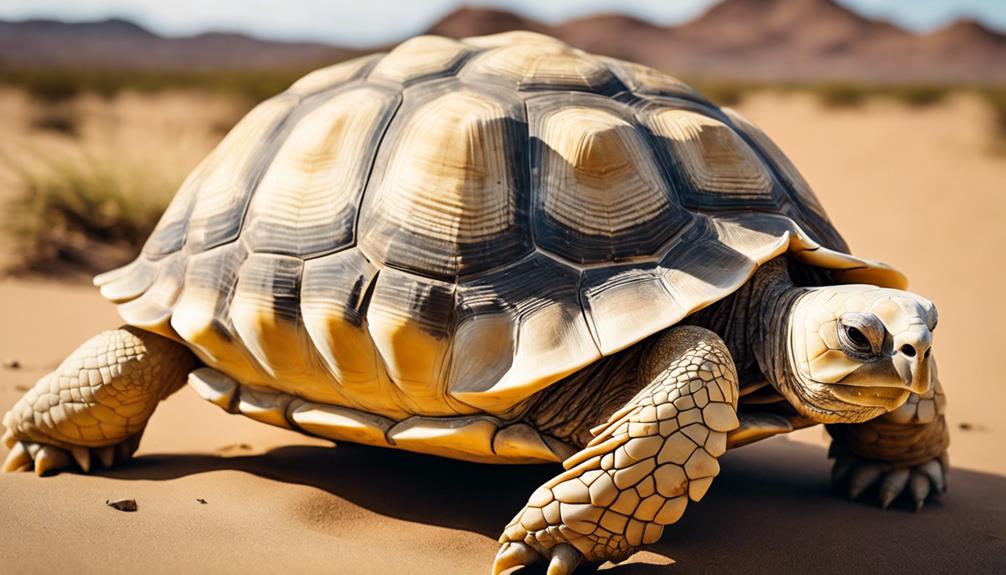If you've ever wondered about the growth trajectory of your Hermann tortoise, the size chart is your key to understanding their development.
From hatchling to adulthood, these creatures undergo significant changes that require careful monitoring and adjustments.
But what happens when your tortoise doesn't quite fit the expected size range?
Understanding these variations and their implications is crucial for providing the best care for your Hermann tortoise companion.
Key Takeaways
- Genetics, diet, and care influence Hermann tortoise size variations.
- Growth charts show males reach 5-7 inches, females 6-9 inches.
- Annual monitoring tracks growth influenced by environment and genetics.
- Balanced diet, suitable habitat, and growth tracking support optimal Hermann tortoise development.
Average Hermann Tortoise Size
When determining the average size of a Hermann tortoise, it's essential to consider factors such as subspecies, genetics, diet, and overall health. Hermann's tortoises are divided into two main subspecies: the Eastern Hermann's tortoise and the Western Hermann's tortoise. Eastern Hermann's tortoises typically reach carapace lengths of 6 to 8 inches, while Western Hermann's tortoises can grow larger, ranging from 7 to 10 inches. The size of Hermann's tortoises can vary within the same subspecies due to genetic differences, diet variations, and overall care provided.
To ensure optimal growth rate and size, it's crucial to provide proper care for your Hermann tortoise. This includes offering a balanced diet rich in leafy greens, vegetables, and fruits, as well as providing a suitable habitat with adequate space for movement and basking. Regular health check-ups and monitoring of growth can help in identifying any issues early on. By focusing on these aspects of care, you can help your Hermann tortoise reach its full potential size based on its genetics and overall well-being.
Growth Chart for Hermann Tortoises
To explore the growth chart for Hermann tortoises, it's important to understand how factors such as genetics, diet, and environment play a crucial role in determining the trajectory of their size over time. The Eastern Hermann tortoise has specific characteristics that influence its growth rate and final size.
Here are some key points to consider:
- Male Hermann tortoises typically reach 5-7 inches, while females grow to 6-9 inches at full adult size.
- Full adult size for Hermann tortoises is usually attained in 7-10 years of age.
- Growth rate varies individually, with factors like environment, genetics, and diet influencing size.
- Monitoring growth annually or biennially can help track the progress of Hermann tortoise growth.
Understanding these aspects can aid in ensuring the proper development and well-being of your Hermann tortoise as it progresses towards its adult size. Tracking their growth regularly allows for adjustments in care and ensures they reach their full potential.
Factors Influencing Tortoise Growth
Factors such as genetics, diet, and environmental conditions significantly influence the growth rate of Hermann tortoises. Genetically, males tend to grow larger and faster than females. Providing a balanced diet is crucial for healthy growth and development. A diet rich in calcium and vitamin D is essential for bone growth and overall well-being.
Environmental conditions, such as temperature and humidity levels, also play a role in determining the growth rate of Hermann tortoises. Monitoring growth patterns annually or biennially can help you track the progress of your tortoise's growth and identify any potential issues early on. Growth spurts are common in Hermann tortoises, so fluctuations in growth rate shouldn't cause concern as long as overall growth trends are consistent.
Monitoring Hermann Tortoise Growth
To properly monitor the growth of a Hermann tortoise, start by measuring the distance from the wall to the back tip of its shell. This method provides a reliable indicator of growth progress over time. Here are some key points to consider when monitoring the growth of your Hermann tortoise:
- Annual Tracking: Regularly measure your tortoise's shell length to track growth patterns accurately.
- Males vs Females: Note that males tend to grow larger and faster than females, regardless of subspecies.
- Growth Spurt: Growth may not be entirely linear; occasional spurts are common during development.
- Health Assessment: Monitoring growth is essential for assessing the overall health and development progress of your Hermann tortoise.
Supporting Healthy Tortoise Development
Support your Hermann tortoise's healthy development by ensuring a balanced diet rich in leafy greens and vegetables to promote optimal growth and well-being. Proper nutrition is essential for the well-being of your baby tortoise.
Leafy greens like dandelion greens, collard greens, and endive should be staples in their diet, along with a variety of vegetables. Adequate calcium and vitamin D levels are crucial for optimal bone growth, especially in smaller species.
Ensure your tortoise habitat includes access to UVB and UVA light to aid in calcium absorption. Monitoring growth annually is key to assessing development accurately.
Providing proper care and attention to your tortoise's diet and habitat will support healthy growth. Remember, a well-rounded diet, appropriate lighting, and consistent monitoring of growth are vital for the overall health and development of your Hermann tortoise.
Conclusion
In conclusion, when it comes to ensuring the optimal growth and development of your Hermann tortoise, knowledge is key. By following the guidelines outlined in the Hermann Tortoise Size Chart, you can provide your beloved pet with the care and support it needs to thrive.
Remember, just like a tortoise slowly but steadily makes its way, your efforts in monitoring growth and providing a suitable environment will ultimately lead to a healthy and happy companion for years to come.


